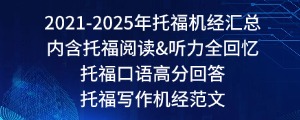2014-03-27 13:47:51 来源:新东方在线整理托福资料下载
TPO13 Lecture 1
City planning
Narrator:
Listen to the lecture in the city planning class.
Professor:
In the last 15 years or so, many American cities have had difficulties in maintaining a successful retail environment. Business owners in the city centers or the downtown areas have experienced some financial losses, because of the city movement of the people out of the city and then into suburbs. In general, downtown areas, just don’t have that many residential areas, not that many people live there. So what did city planners decide to do about it? While, one way they’ve came up with the some ways to attract more people, to shop downtown was by creating pedestrian malls. Now, what is a pedestrian mall? It’s a pretty simple concept really, it is essentially an outdoor shopping area designed just for people on foot. And… well, unlike many of other shopping malls that are built in suburb nowadays, these pedestrian malls are typically located in the downtown areas of the city. And there are features like white sidewalks, comfortable outdoor sitting and maybe even for tens---UN…you know art. There are variations on this model of course, but the common denominators are always an idea of creating a shopping space that will get people to shop in the city without needing their cars. So I am sure you can see how heavy an area that off-limits to automobile traffic would be ideal for heavily populated city where, well, the streets will otherwise be bustling with noise, unpleasant traffic congestion. Now the concept which originated in Europe was adopted by American city planners in the late 1950s. And since then, a number of Unites States’ cities have created the pedestrian malls. And many of them have been highly successful. So what does city planner learns about ** these malls succeed? Well, there are two critical factors to consider when creating the pedestrian malls--- location and design. Both of which are equally important. Now let's start with location. In choosing a specific location for pedestrian mall, there are in fact two considerations. Proximity to potential customers, UN…that's we'll call it customer base and accessibility to public transportation which we will get into just a moment. Now, for a customer base, the most obvious example would be a large office building since the employees could theoretically go shopping after work or during their lunch hour, right? Another really good example is convention center which typically has a hotel and large meeting spaces to draw visitors to the city for major business conferences and events. But ideally, the pedestrian malls will be used by local residents, not just people working in the city or visiting the area. So that's where access to the public transportation comes in, if… if the designer planed to locate the malls in central transportation hub, like bus terminal, a major train, subway station or they work with city officials to create sufficient parking areas, not too far from the mall, which make sense because people can drive into the mall area or then they need easy access to it. OK, so that's location, but what about design? Well, design doesn't necessarily include things like sculptures or decorative walkways or… or even eye catching window displays, you know art. Although I bet the first to admen those things are ascetically appealing, however, visually pleasing sights, while there are not a part of pedestrian malls design that matter than most. The key consideration is a compact and convenient layout. One which allows pedestrians to walk from one end of the mall to the other in just a few minutes, so you can get the major stores, restraints and other central places without having to take more than one or two turns. Now, this takes a careful uncreative planning. But now what if one ingredient to this planning recipe is missing? There could quite be possibly long lasting effects. And I think a good example is pedestrian mall in the Louisville Kentucky for instance. Now when the Louisville mall was built, it has lots of visual appeal, it was attractively designed, right in the small part of downtown and it pretty much possessed other design elements for success. But now, here is my point about location comes into play. There wasn't a convention center around to help joining visitors and was the only nearby hotel eventually closed down for that same reason. Well, you can imagine how these malls affected local and pedestrian malls business owners. Sort of what was we called it a chain reaction. It wasn't until a convention center and a parking garage was built about decades later that malls started to be successful.
本文关键字: 托福听力TPO10原文 托福听力TPO13文本

 资料下载
资料下载
2021-2024托福机经试题|答案|范文下载
发布时间:2024-02-21关注新东方在线托福
回复【XDF】获取
托福全科备考资料大礼包
发布时间:2024-02-21关注新东方在线托福
回复【XDF】获取
托福正价课试听课程包
发布时间:2024-02-21关注新东方在线托福
回复【XDF】获取
托福定制备考规划
发布时间:2024-02-21关注新东方在线托福
回复【XDF】获取
托福TPO免费模考
发布时间:2024-02-21关注新东方在线托福
回复【XDF】获取
托福免费水平测试
发布时间:2024-02-21关注新东方在线托福
回复【XDF】获取
托福写作新题型模拟题+范文汇总[ETS发布]
发布时间:2023-07-30关注新东方在线托福
回复【XDF】获取
2023全年托福机经PDF版下载
发布时间:2023-06-17关注新东方在线托福
回复【XDF】获取
2022全年托福机经PDF版下载
发布时间:2023-06-17关注新东方在线托福
回复【XDF】获取
2022全年写作托福机经整理
发布时间:2023-01-13关注新东方在线托福
回复【XDF】获取
2022年托福考后题目回忆
发布时间:2023-01-13关注新东方在线托福
回复【XDF】获取
托福口语黄金80题附录音
发布时间:2023-01-13关注新东方在线托福
回复【XDF】获取
新东方IBT写作网络课堂录音[.rar]
发布时间:2023-01-13关注新东方在线托福
回复【XDF】获取
21天托福听力提升计划
发布时间:2023-01-13关注新东方在线托福
回复【XDF】获取
不怕跑题偏题,这份写作资料请收好
发布时间:2023-01-13关注新东方在线托福
回复【XDF】获取
托福阅读提分技巧锦囊妙计
发布时间:2023-01-13关注新东方在线托福
回复【XDF】获取
口语拖后腿?因为你缺少这套万能句式资料
发布时间:2019-11-01关注新东方在线托福
回复【XDF】获取
攻破托福听力难关的资料包
发布时间:2023-01-13关注新东方在线托福
回复【XDF】获取
看剧学英语,经典美剧一键获取
发布时间:2019-11-01关注新东方在线托福
回复【XDF】获取
原版外刊资源合集|精心打包整理
发布时间:2019-11-01关注新东方在线托福
回复【XDF】获取

关注新东方在线托福,
回复【XDF】获取大礼包

版权及免责声明
1,"新东方在线"上的内容,包括文章、资料、资讯等, 本网注明"稿件来源:新东方在线"的,其版权 均为"新东方在线"或北京新东方迅程网络科技有限公司所有 ,任何公司、媒体、网站或个人未经授权不得转载、链接、转贴或以其他方式使用。已经得到 "新东方在线"许可 的媒体、网站,在使用时必须注明"稿件来源:新东方",违者本网站将依法追究责任。
2, "新东方在线" 未注明"稿件来源:新东方"的 文章、资料、资讯等 均为转载稿,本网站转载出于传递更多信息之目的,并不意味着赞同其观点或证实其内容的真实性。如其他媒体、网站或个人从本网站下载使用,必须保留本网站注明的"稿件来源",并自负版权等法律责任。如擅自篡改为 " 稿件来源:新东方 " ,本网站将依法追究其法律责任。
3,如本网转载稿涉及版权等问题,请作者见稿后在两周内与新东方在线联系。


 资料下载
资料下载
关注新东方在线托福
回复【XDF】获取
关注新东方在线托福
回复【XDF】获取
关注新东方在线托福
回复【XDF】获取
关注新东方在线托福
回复【XDF】获取
关注新东方在线托福
回复【XDF】获取
关注新东方在线托福
回复【XDF】获取
关注新东方在线托福
回复【XDF】获取
关注新东方在线托福
回复【XDF】获取
关注新东方在线托福
回复【XDF】获取
关注新东方在线托福
回复【XDF】获取
关注新东方在线托福
回复【XDF】获取
关注新东方在线托福
回复【XDF】获取
关注新东方在线托福
回复【XDF】获取
关注新东方在线托福
回复【XDF】获取
关注新东方在线托福
回复【XDF】获取
关注新东方在线托福
回复【XDF】获取
关注新东方在线托福
回复【XDF】获取
关注新东方在线托福
回复【XDF】获取
关注新东方在线托福
回复【XDF】获取
关注新东方在线托福
回复【XDF】获取

关于我们 - 商务合作 - 广告服务 - 代理商区域 - 客服中心 - 在线留言 - 退换货说明 - 合作伙伴 - 联系我们 - 人员招聘 - 网站地图 - 热点关注 - 寓乐优学
新东方教育科技集团旗下成员公司 全国客服专线:400-676-3300
Copyright (C) 2000-2013 koolearn.com Inc. All rights reserved. 新东方在线 版权所有
京ICP证050421号 京ICP备05067669号 京公网安备11010802017616号 网络视听许可证0110531号